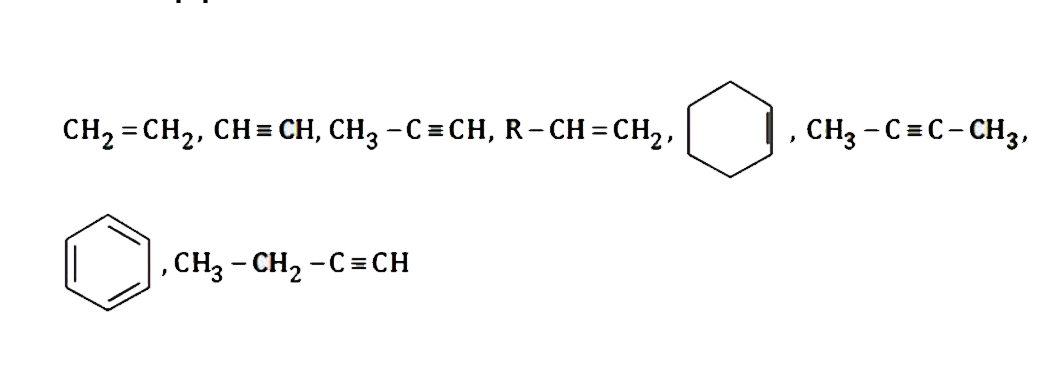Which of the following will not react with an ammonical silver nitrate solution :
(a)CH3C=CH
(b)(CH3)2CH−C=CH
(c)CH3C=CCH3
(d)HC=CH
The correct Answer is:C
To determine which of the given compounds will not react with ammonical silver nitrate solution (Tollens' reagent), we need to understand the properties of terminal and non-terminal alkynes.
1. Understanding Tollens' Reagent: Tollens' reagent, which is ammonical silver nitrate, is known to react specifically with terminal alkynes. This is because terminal alkynes possess an acidic hydrogen atom that can be replaced by silver ions (Ag⁺) from the reagent.
2. Identifying Terminal Alkynes: Terminal alkynes are characterized by having a triple bond at the end of the carbon chain, which allows for the presence of an acidic hydrogen atom. In contrast, internal alkynes do not have this acidic hydrogen as the triple bond is located between two carbon atoms.
3. Analyzing the Given Compounds: We need to analyze each of the four compounds provided in the question:
- Compound A: A terminal alkyne (e.g., 1-butyne).
- Compound B: Another terminal alkyne (e.g., 2-butyne).
- Compound C: A terminal alkyne (e.g., 3-pentyne).
- Compound D: A non-terminal alkyne (e.g., 2-butyne).
4. Identifying the Non-Reactive Compound: Among the compounds, the one that is a non-terminal alkyne will not react with Tollens' reagent. For example, 2-butyne is an internal alkyne and does not have an acidic hydrogen, thus it will not react with ammonical silver nitrate.
5. Conclusion: Therefore, the compound that will not react with ammonical silver nitrate solution is the non-terminal alkyne, which is Compound D (e.g., 2-butyne).
Final Answer:
The compound that will not react with ammonical silver nitrate solution is Compound D (the non-terminal alkyne).
---
- Compound A: A terminal alkyne (e.g., 1-butyne).
- Compound B: Another terminal alkyne (e.g., 2-butyne).
- Compound C: A terminal alkyne (e.g., 3-pentyne).
- Compound D: A non-terminal alkyne (e.g., 2-butyne).
The compound that will not react with ammonical silver nitrate solution is Compound D (the non-terminal alkyne).
Topper's Solved these Questions
- ALKENE, ALKANE & ALKYNE BOOK - ALLENCHAPTER - ALKENE, ALKANE & ALKYNE EXERCISE - EXERCISE-2
103 Videos
- ALKENE, ALKANE & ALKYNE BOOK - ALLENCHAPTER - ALKENE, ALKANE & ALKYNE EXERCISE - EXERCISE-3
99 Videos
- ALKENE, ALKANE & ALKYNE BOOK - ALLENCHAPTER - ALKENE, ALKANE & ALKYNE EXERCISE - EXCERSISE-3
28 Videos
- AIIMS 2019BOOK - ALLENCHAPTER - AIIMS 2019EXERCISE - CHEMISTRY
40 Videos
- ALKYL AND ARYL HALIDEBOOK - ALLENCHAPTER - ALKYL AND ARYL HALIDEEXERCISE - EXERCISE-05 (B)
35 Videos
Similar Questions
Knowledge Check
Which of the following will not give white precipitate with
ammoniacal silver nitrate solution ?ACH3−C≡C−CH3B C
C D
D
How many of these compounds can react with ammoniacal silver nitrate solution to give white ppt.

View SolutionWhich of the following reaction with ammonical AgNO3 solution.
View SolutionState one relevant observation for each of the following reactions :
Addition of silver nitrate solution to sodium chloride solution.
View SolutionWhich of the following reaction(s) is/are incorrect for silver nitrate?
View SolutionWrite the condition for each subquestion in not more than two sentences
Ethyne and its derivatives will give white precipitate with ammonical silver nitrate solution.
View SolutionWhich among the following is not obtained by treating aqueous silver nitrate with hypophosphorous acid?
View SolutionIdentify the acid which matches the following description
The acid on mixing with silver nitrate solution produces a white precipitate which is soluble in excess ammonium hydroxide.
View Solution
